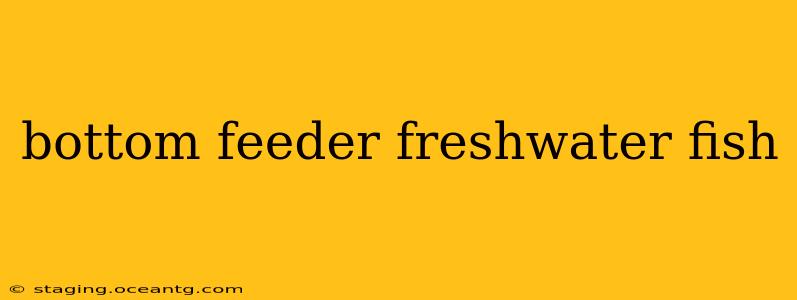Freshwater aquariums thrive on biodiversity, and a crucial part of that is the role of bottom feeders. These unsung heroes of the underwater world play a vital role in maintaining a clean and healthy tank environment. Understanding different types of bottom-feeding fish, their specific needs, and how they contribute to your aquarium's ecosystem is key to successful fishkeeping. This guide explores the fascinating world of freshwater bottom feeders, answering common questions and offering valuable insights for both beginners and experienced aquarists.
What are Bottom Feeder Fish?
Bottom feeder fish, also known as benthic fish, are species that primarily forage for food on the substrate, or bottom, of their aquatic habitat. They play a critical role in the ecosystem by consuming decaying organic matter, uneaten food, and algae. This scavenging behavior helps prevent the buildup of waste, improving water quality and overall tank health. Their feeding habits naturally contribute to a cleaner, more balanced aquarium environment.
What are some examples of common bottom feeder freshwater fish?
Several popular freshwater fish species are known for their bottom-feeding habits. Some popular choices include:
-
Plecostomus (Pleco): These are arguably the most well-known bottom feeders, prized for their algae-eating capabilities. There's a wide variety of pleco species, ranging in size and appearance. It's crucial to research the specific species before purchasing, as some can grow incredibly large.
-
Corydoras Catfish: These peaceful, schooling fish are popular community tank inhabitants. They're effective at cleaning up leftover food and detritus from the bottom.
-
Otocinclus Catfish (Oto): Smaller than Corydoras, Otos are excellent algae eaters, particularly effective at removing algae from hard-to-reach places in the tank.
-
Chinese Algae Eater: While effective at algae control in smaller tanks, they can become aggressive towards other fish as they mature and should be carefully considered for community setups.
-
Loaches: This diverse group includes various species, many of which are excellent bottom feeders. Their specific needs vary depending on the species, so thorough research is essential.
What is the best bottom feeder fish for a beginner?
For beginner aquarists, Corydoras catfish are often recommended. They're relatively hardy, peaceful, and adaptable to various water parameters. Their smaller size also makes them suitable for smaller tanks. Otocinclus catfish are another good option for beginners if their specific needs regarding water quality and algae availability are met.
How many bottom feeders should I have in my tank?
The number of bottom feeders you should keep depends on the size of your tank and the specific species. Overstocking can lead to competition for resources and stress on the fish. Always research the adult size and space requirements of the species you choose before introducing them to your tank. A good rule of thumb is to allow ample space for each fish to move and forage comfortably.
Do bottom feeders clean the tank completely?
While bottom feeders are excellent at cleaning up a significant portion of waste and debris, they don't eliminate the need for regular tank maintenance. Regular water changes, gravel vacuuming, and filter maintenance remain crucial for maintaining a healthy aquarium. Bottom feeders should be seen as a supplement to, not a replacement for, proper aquarium care.
What do bottom feeder fish eat?
The diet of bottom feeders varies depending on the species. Many are omnivores, consuming algae, decaying plant matter, uneaten food, and small invertebrates. It's essential to provide a varied diet to ensure their nutritional needs are met. Sinking pellets or wafers specifically designed for bottom feeders are often a good option, supplemented with occasional live or frozen foods.
Can bottom feeders live with other fish?
Many bottom-feeding species are peaceful and can coexist with other community fish. However, it's crucial to research the compatibility of different species before introducing them to the same tank. Some larger plecos, for example, might be aggressive towards smaller tank mates. Careful planning and research are essential to ensure a harmonious community tank.
This guide provides a starting point for understanding the world of freshwater bottom feeder fish. Remember to always research the specific needs of the species you choose before introducing them to your aquarium. With proper care and attention, these fascinating creatures will contribute significantly to a thriving and healthy underwater ecosystem.
